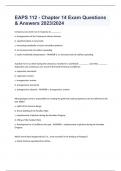Resume
Samenvatting klinisch redeneren - neuro
- Établissement
- Universiteit Gent (UGent)
samenvatting klinisch redeneren bij neurologische aandoeningen inclusief: theorie en praktijk, parkinson, CVA, dwarslaesie, KNO nog te bekijken: extra oefeningen praktijk
[Montrer plus]












